|
Fokker E.V / D.VIII
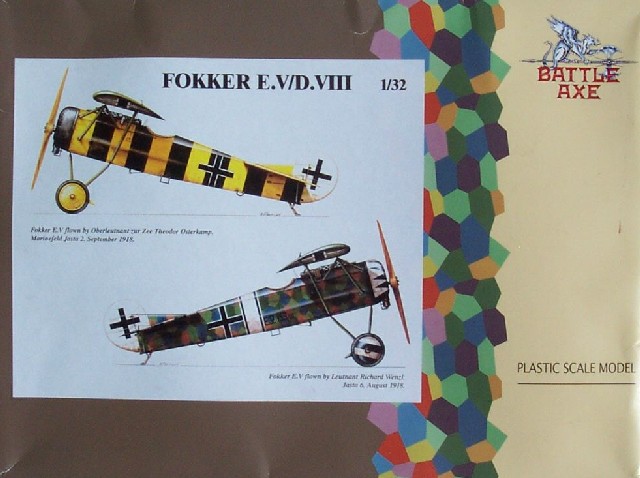
Battle Axe 1/32
S
u m m a r y
|
| Catalogue Number: |
Battle Axe Fokker E.V /
D.VIII kit Réf.32BA03 |
| Scale: |
1/32 |
| Contents and Media: |
See text below |
| Price: |
USD$83.46 from Squadron.com
|
| Review Type: |
FirstLook |
| Advantages: |
Accurate mouldings,
resin and photo etched parts, thin decals |
| Disadvantages: |
|
| Recommendation: |
Recommended for
modellers with some experience. |
Reviewed by Robert Baumgartner

Battle
Axe's 1/32 scale Fokker E.V / D.III
is available online from Squadron.com
The Fokker E.V / D.VIII has
always been popular amongst World War I modellers despite the aircraft
not having contributed much during this conflict.
Only one victory is known to
have been confirmed in the type, this being by Lt. Emil Rolff of Jasta 6
on 17 August 1918. Sadly he lost his life 2 days later when the wing of
his parasol fighter failed.
This is the third release from
Battle Axe in their line of 32nd scale WWI aircraft. It is a
logical choice for a limited run kit, as the aircraft itself was very
simple to manufacture.
Upon opening the box, the
modeller is greeted by a single very large plastic sprue, a bag of resin
and a fret of photo-etched parts.
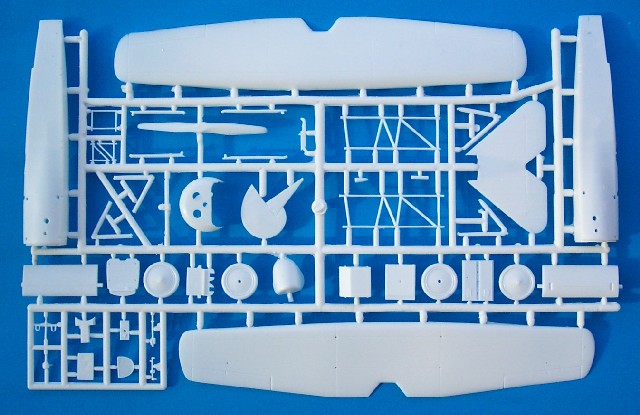
Comparing the plastic to
previous releases it is clear that Battle Axe have improved their
techniques. The surface of the parts is a lot smoother than we’ve seen
with either of the earlier kits and the detail is more refined. An
example of this is the lovely external representation of the tubular
structure on the fuselage halves.
A basic cockpit is provided and
those items made of plastic are the floorboard, rudder bar, control
column, seat (with mounting), rear “fabric” screen, compass mounting,
and tubular framework. Some of the smaller items are best scratch built
using the originals as a pattern. The “throttle”, instrument panel, and
seat belts are all found on the p-e sheet with more plastic parts taking
care of the fuel/oil tank, and ammunition box.
The cantilever wing and axle
fairing are in two halves and both feature engraved panel lines.
Personally I would fill these in, as they are a bit heavy to represent
what appeared on these plywood items. The tailplane is nicely done with
a restrained representation of the ribs.
The rest of the plastic parts
consist of two part wheels, struts, propeller and cowling. The latter
misses the characteristic “lip” that most other manufacturers fail to
reproduce which the builder really needs to add in this scale.
The resin parts are a real
delight. You get an Oberusal with separate intake manifolds as well as a
pair of “Spandaus”. With the latter, photo etched jackets are provided
if you wish to refine the nicely done resin items.
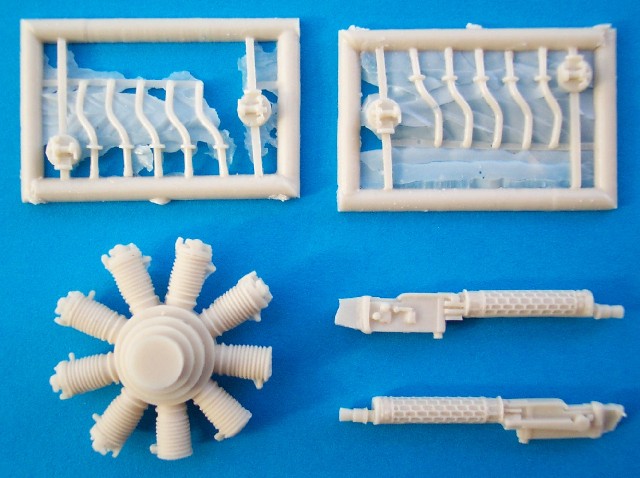
The remaining parts on the p-e
fret include stitching, ammo belts, prop boss and control horns.
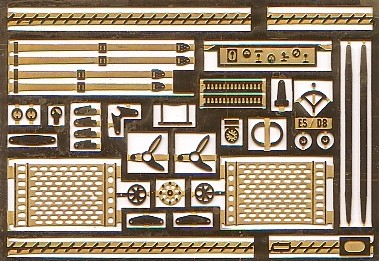
The major parts were checked
against a couple of sets of plans and this revealed no problems with
accuracy.
A set of decals is included for
two aircraft. The printing is done on very thin carrier film and my
examples were in perfect register. The lozenge was a bit “bright” for my
tastes and I would recommend a “wash” or light over-spray to dull them
down a bit.
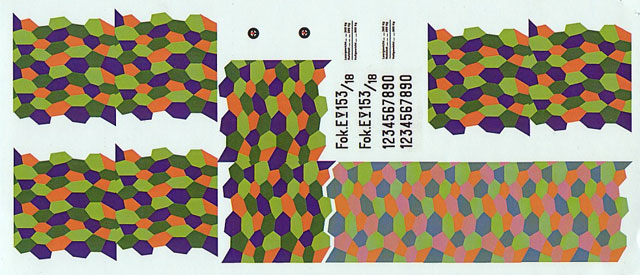
Click
the thumbnails below to view larger images:
The typical Jasta 6 décor is
supplied for the cowl, as is the black and white fuselage band for
Wenzel’s machine.
Also included are enough serial
numbers to do just about any aircraft you wish.
Option 1 – Fok. EV 154/18
flown by Leutnant Richard Wenzl of Jasta 6
Wenzl survived the war with
12 victories, later passing away in 1957.
It was on the 17 May 1918
that he transferred to Jasta 6, having previously been with Jasta
11, and it was in the former that he scored his last 10 victories.
Option 2 – Fok. EV /D.VII
flown by Oberleutnant zur See Theoodor Osterkamp
After a brief stint with MFJ
I where he scored 6 victories, Osterkamp was posted to MFJ II where
he remained until the end of the war. He commanded this unit and
scored 26 more times before the war ended.
His tally didn’t end there
though. He went on to join the Luftwaffe in 1935 and in 1939 was
given the command of JG51. Here he scored six more victories, thus
making him an ace in two wars! Osterkamp survived WWII and died in
1975.
This is quite a comprehensive
package for a limited production kit. All the basics are there and
naturally in this scale the detailer can go berserk.
Obviously this kit is not for
the novice, but it was never meant to be.
Despite this, the simplicity of
the subject should encourage even the most apprehensive modeller to have
a go.
Recommended
Thanks to
Squadron.com for the review
sample.
Review and Images Copyright © 2005 by
Robert Baumgartner
Page Created 03 January, 2005
Last updated 03 January, 2005
Back to HyperScale Main Page
Back to Reviews Page
|
Home | What's
New | Features
| Gallery |
Reviews | Reference
| Forum
| Search